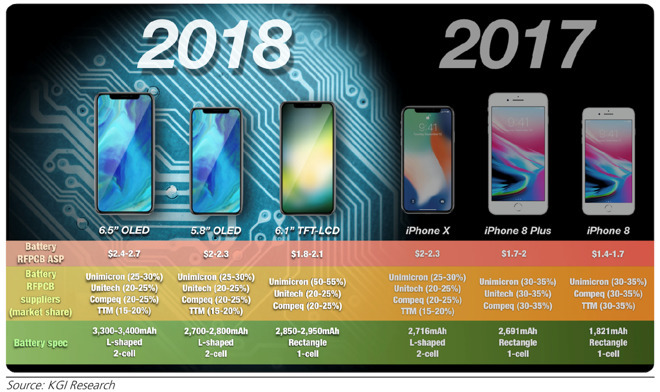Yet another supply chain source has chimed in on the 2018 iPhone release lineup, with it claiming that based on component orders, the 6.5-inch OLED 'iPhone X Plus' expected in the fall will hold the lion's share of sales.
The report the Korean Language trade publication The Bell is seeing 45 million panels for the high-end 6.5-inch device, just a little less than half the screens ordered. IF the reports are accurate, Apple has ordered about 25 million screens for the smaller 5.8-inch OLED device, and 30 million 6.1-inch screens for the LCD release.
The Bell does not have a reliable track record for predicting Apple's future iPhone plans. Other reports attributable to the publication include an unverifiable claim from 2017 that Apple was working on a foldable iPhone with LG for release in 2020, as well as the only claims that the 6.1-inch LCD iPhone slated for release in the fall alongside two OLED models will ship later because of issues cutting a notch in a LCD screen.
It's not certain how these numbers compare to Katy Huberty's predictions from Monday, of Apple ordering 90 million iPhones spanning the launch quarter for the 2018 iPhone rollout. The screen orders cited by Tuesday's report may be for a longer period, or include screens set aside for service purposes.
Most sources now claim that all three will have the TrueDepth camera array and use Face ID, but the LCD model will be singled out as a cost-effective model while the OLED versions will have more premium pricing and specifications.
Two report sources claim that, in order to avoid any manufacturing delays that allegedly occurred during the initial production of the iPhone X, suppliers were informed by Apple to prepare for the two OLED models earlier than "normal" in 2018. Increased preparation ahead of production could fend off component shortages and quality control issues that were said to have caused last year's manufacturing problems.
There is some speculation that the LCD model will be delayed, due to production yield issues surrounding its touchscreen functionality, but the situation is apparently improving. Bottlenecks in integrating the TrueDepth camera array into the LCD screen are also said to be easing, removing another hurdle that could cause manufacturing delays.
Foxconn will continue to be the main iPhone assembler this year, with it said to handle all 5.8-inch OLED units and 80 to 90 percent of the 6.5-inch OLED version, as well as 30 percent of LCD model orders. Pegatron is identified as taking 60 percent of the LCD orders and between 10 and 15 percent of the 6.5-inch OLED model orders, while Wistron makes up the remainder.
The 5.8-inch OLED model is said to be priced be around $800 to $900, with the 6.5-inch OLED "iPhone X Plus" priced between $900 to $1000. The LCD model is likely to be between $600 to $700, according to the supply chain as well.
Apple CEO Tim Cook has previously spoken out about such reporting and supply chain analysis, advising that industry observers should avoid relying too heavily on these types of rumors.
"The supply chain is very complex, and we obviously have multiple sources for things," Cook advised in 2013, adding that some reports could were likely based on a "single data point."
 Mike Wuerthele
Mike Wuerthele







-m.jpg)






 Marko Zivkovic
Marko Zivkovic
 Christine McKee
Christine McKee
 Andrew Orr
Andrew Orr
 Andrew O'Hara
Andrew O'Hara
 William Gallagher
William Gallagher


 Bon Adamson
Bon Adamson


-m.jpg)



22 Comments
looks like they are going to try to force a large phone on those that don't want it and have to pay more for OLED just to get the smallest screen.
That sounds like a full-year order for the OLED panels. The X is on track to sell a total of 40 million in its initial year, and this was supposed to be a supercycle. You've also got multiple reports saying the LCD device is expected to be the most popular which this report contradicts if the orders are for the same period.
Sales have been stagnant since the iPhone 6. Next year's sale will likely be in the 215-235 million range. I'm thinking the OLED devices will account for about 25% of that total (around 60 million) split 40M for the plus and 20M for the regular which pretty much matches this report.
However, I think the new LCD device will account for about 1/3 of sales next year which would be about 75 million units. Maybe Apple is playing it safe and starting out slow, or maybe Apple is more confident in acquiring sufficient panels on short notice, but either way I bet 25 million is woefully short of what Apple will actually sell next year. If it does sell in the $600-$700 range I bet Apple drops the iPhone 8 from the lineup and keeps the 7 around for the $500 price point.